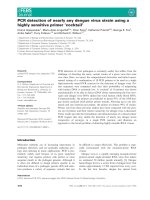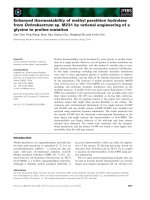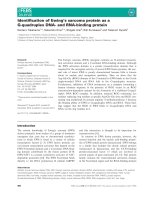Tài liệu Báo cáo khoa học: "Generative Power of CCGs with Generalized Type-Raised Categories" pptx
Bạn đang xem bản rút gọn của tài liệu. Xem và tải ngay bản đầy đủ của tài liệu tại đây (272.56 KB, 3 trang )
Generative Power of CCGs with Generalized Type-Raised Categories
Nobo Komagata
Department of Computer and Information Science
University of Pennsylvania
Philadelphia, PA 19104
komaga t a@ 1 inc. c i s. upenn, edu
Abstract
This paper shows that a class of Combinatory
Categorial Grammars (CCGs) augmented with
a linguistically-motivated form of type raising
involving variables is weakly equivalent to the
standard CCGs not involving variables. The
proof is based on the idea that any instance of
such a grammar can be simulated by a standard
CCG.
1 Introduction
The class of Combinatory Categorial Grammars (CCG-
Std) was proved to be weakly equivalent to Linear Index
Grammars and Tree Adjoining Grammars (Joshi, Vijay-
Shanker, and Weir, 1991; Vijay-Shanker and Weir, 1994).
But CCG-Std cannot handle the generalization of type
raising that has been used in accounting for various lin-
guistic phenomena including: coordination and extrac-
tion (Steedman, 1985; Dowty, 1988; Steedman, 1996),
prosody (Prevost and Steedman, 1993), and quantifier
scope (Park, 1995). Intuitively, all of these phenomena
call for a non-traditional, more flexible notion of consti-
tuency capable of representing surface structures inclu-
ding "(Subj V) (Obj)" in English. Although lexical type
raising involving variables can be introduced to derive
such a constituent? unconstrained use of variables can
increase the power. For example, a grammar involving
(T\z)/(T\v) can generate a language
A"B"C"D"E"
which CCG-Std cannot (Hoffman, 1993).
This paper argues that there is a class of grammars
which allows the use of linguistically-motivated form of
type raising involving variables while it is still weakly
equivalent to CCG-Std. A class of grammars, CCG-
GTRC, is introduced in the next section as an extension
to CCG-Std. Then we show that CCG-GTRC can actually
be simulated by a CCG-Std, proving the equivalence.
°Thanks to Mark Steedman, Beryl Hoffman, Anoop Sarkar,
and the reviewers. The research was supported in part by NSF
Grant Nos. IRI95-04372, STC-SBR-8920230, ARPA Grant
No. N66001-94-C6043, and ARID Grant No. DAAH04-94-
G0426.
IOur lexieal rules to introduce type raising are non-recursive
and thus do not suffer from the problem of the overgeneration
discussed in (Carpenter, 1991).
2 CCGs with Generalized Type-Raised
Categories
In languages like Japanese, multiple NPs can easily form
a non-traditional constituent as in "[(Subj I Objl) & (Subj2
Obj2)] Verb". The proposed ~ammars (CCG-GTRC)
admit lexical type-raised categories (LTRC) of the form
"1"/(T\a) or'l'\ (T/a) where T is a variable over categories
and a is a constant category (Const). 2 Then, composition
of LTRCs can give rise to a class of categories having
the formT/(T\a
\at)
or T\
(T/a /at),
representing
a multiple-NP constituent exemplified by "Subjl Objt".
We call these categories generalized type-raised cate-
gories (GTRC) and each
ai
of a GTRC an argument (of
the GTRC).
The introduction of GTRCs affects the use of combi-
natory rules: functional application ">: z/y + y , z"
and generalized functional composition ">B ~ (x) :
z/y + ylzt [zk
zlzl [z~" where k is bounded by a
grammar-dependent
kma~ as
in CCG-Std. 3 This paper
assumes two constraints defined for the grammars and
one condition stipulated to control the formal properties.
The following order-preserving constraint, which
follows more primitive directionality features (Steedman,
1991), limits the directions of the slashes in GTRCs.
(1) In a GTRC "1"[o
(T[,a
Ira,), the direction of [0 must
be the opposite to any of In, , ]b
This prohibits functional composition '>B×' on
'GTRC+GTRC' pairs so that
"T/(T\A\B) + U\(U/C/D)"
does not result in
T\ (T\A\B/C/D)
or U/(UIC/D\A\B). That is, no
movement
of arguments across the functor is allowed.
The variable constraint states that:
(2) Variables are limited to the defined positions in
GTRCs.
This prohibits '>B k (×)' with k > I on the pair
2Categories are in the "result-leftmost" representation and
associate left. Thus
a/b/c
should be read as
(a/b)/c
and re-
turns
a/b
when an argument c is applied to its right. A Z
stand for nonterminals and a, ,z for complex, constant
categories.
3There are
also backward rules (<) that are analogous to
forward rules (>).
Crossing
rules where zt is found in the
direction opposite of that of y are labelled with 'x'. 'k' re-
presents the number of arguments being passed. '[' stands for
a directional meta-variable for {/, \}.
513
'Const+GTRC'. For example, '>B 2' on
"A/B +
T/(TkC)" cannot realize the unification of the form
"A/B +
TrITe./(TtITz\C)" (with T = TilT,_) resulting in
"AIT,./(BITz\C)".
In order to assure the expected generative capacity, we
place a condition on the use of rules. The condition can
be viewed in a way comparable to those on rewriting rules
to define, say, context-free grammars. The bounded ar-
gument condition ensures that every argument category
is bounded as follows:
(3) '>B (x)' should not apply to the pair
'Const+GTRC'.
For example, this prohibits
"A/ B + T~ (TkC \Ct)
A/(B\C, \Cl)",
where the underlined argument can
be unboundedly large. These constraints and condition
also tell us how we can implement a CCG-GTRC system
without overgeneration.
The possible cases of combinatory rule application are
summarized as follows:
(4) a. For 'Const+Const', the same rules as in CCG-Std
are applicable.
b. For 'GTRC+Const', the applicable rules are:
(i) >: e.g., "T/(TkAkB) +
SkAkB S"
(ii)
>B k
(x): e.g.,
"T/(TkA\B) +
SkA\BkC/D S\C/D'"
c. For 'Const+GTRC', only '>' is possible: e.g.,
"S/ (S/ (S\B))
+r/(T\B) , S"
d. For 'GTRC+GTRC', the possibilities are:
(i) >:
e.g.,
"T/(mx
(S/A/B)) +
Tk
(T/A/B)
(ii) >B: e.g., "T/(T\A\B) + T/(T\C\D)
T/(TkAkB\C\D)"
CCG-GTRC is defined below where g, ta and ~a,rc re-
present the classes of the instances of CCG-Std and CCG-
GTRC, respectively:
Definition 1 Gatrc is the collection of
G's
(extension of
a G E G, ta)
such that:
l. For the lexical function f of G (from terminals to
sets of categories), if a E f (a),
f'
may additionally
include { (a, T/(T\a)), (a, T\ (T/a)) }.
2. G' may include the rule schemata in (4).
The main claim of the paper is the following:
Proposition 1 ~9*~e is weakly equivalent with ~,ta.
We show the non-trivial direction: for any G' E Ggt~c,
there is a
G" 6 ~,,a
such that
L (G') = L (G").
As G'
corresponds to a unique G E ~,ta, we extend G" from G
to simulate
G',
then show that the languages are exactly
the same.
3 Simulation of CCG-GTRC
Consider a fragment of CCG-GTRC with a lexical
function f such that f(a) = {A,T/(T\A)},f(b) =
{ A, T/(TkA) }, f (¢) = {SNA\B}. This fragment can
generate the following two permutations:
(5) a. ~ b ¢
,/(T\a) +
>
S\A
>
$
b. b a
c
r/(r\B) + r/(r\a) + s\a\8
.>BX
S\B
>
S
Notice that (5b) cannot be generated by the original CCG-
Std where the lexicon does not involve GTRCs. In order
to (statically)
simulate
(5b) by a CCG-Std, we add
S\BkA
to the value of f" (c) in the lexicon of
G'.
Let us call
this type of relation between the original
S\A\B
and the
S\B]\A]
wrapping, due to its resemblance to the
new
operation of the same name in (Bach, 1979). There are
two potential problems with this simple augmentation.
First, wrapping may affect unboundedly long chunks of
categories as exemplified in (6). Second, the simulation
may overgenerate. We discuss these issues in turn.
(6) "T/(T\A)+T/(TkB)+ +T/(T\A)+T/(T\B)+
s\a\B \a\B\c - s\c"
We need
S\~ \AXB kAkB 1
which can be the result of
unboundedly-long compositions, to simulate (6) without
depending on the GTRCs. Intuitively, this situation is
analogous to long-distance movement of C from the po-
sition left of
SkAkB kC
to the sentence-initial position.
In order to deal with the first problem, the following
key properties of CCG-GTRC must be observed:
(7) a. Any derived category is a combination of lexical
categories. For example,
SkAkB\A\B \AkBkC
may be derived from
"SkAkBkC + + SkAkBkS + SkAkBkS"
by
'<B'.
b. Wrapping can occur only when GTRCs are invol-
ved in the use of'> Bkx ' and can only
cross
at most
km~=
arguments. Since there are only finitely-
many argument categories, the argument(s) being
passed can be encoded in
afinite store.
For derivable categories bounded by the maximum
number of arguments of a lexical category, we add all
the instances of wrapping required for simulating the ef-
fect of GTRC into the lexicon of G". For the unbounded
case, we extend the lexicon as in the following example:
(8) a. For a category
S\A\B\C,
add
S{\c}\AkB
to the
lexicon.
b. For
SkA\BkS,
add
S{\c}\A\BkS{\c},
S\A\B\C\S{\c} S\C~\S{\c}.
S{\c}
is a new category representing the situation where
\C is being passed across categories. Thus \C which
originatedin
SkAkB\C
in (a) may be passed onto another
514
category in (b), after a possibly unbounded number of
compositions as follows:
(9)
S{\c}\A\B + S{\c}\A\B\S{\c}+ +
S\~S{\c}
S\GJ \A\B \A\B\A\B
Now, both of the permutations in (5) can be derived in
this extension of CCG-Std. The finite lexicon with finite
extension assures the termination of the process. This
covers the case (4bii).
Case (4e) can be characterized by a general pattern
"cl (hi (b\ak \a,))
+ T/(T\ak \a,) * c" where T =
b. Since any argument category is bounded, we can add
b/(b\ak \a~) 6 f'
(al a,) in the lexicon as an idiom.
The other cases do not require simulation as the same
string can be derived in the original grammar.
The second problem of overgeneration calls for
another step. Suppose that the lexicon includes
jr(c) =
{S\A\B},
f(d) =
{S\B\A},
and f(e) =
{E\(S\B\A)}
and that
S\BF~
is added to f(c)
by wrapping. To avoid generating an illegal string
"c e" (in addition to the legal "de"), we label the
state of wrapping as
S\Bt+~o,~pl[ \A~+,~,.~,p] t The
origi-
nal entries can be labelled as
S\Bt
p]\A[ pj and
E\ (S\B[
pj\A[ pl). The lexical, argument cate-
gories, e.g., A, are underspecified with respect to the fea-
ture. Since finite features can be folded into a category,
this can be written as a CCG-Std without features.
4 Equivalence of
the Two
Languages
Proposition
I can be proved by the following lemma (as
a special case where c = S):
Lemma 1 For any G' 6 Ggtre (an extension of G), there
is a G" 6 ~,td such that a string w is derivable from a
constant category c in G' iff (~) w is derivable from c in
Gll •
The sketch of the proof goes as follows. First, we con-
struct G" from G' as in the previous section. Both di-
rections of the lemma can be proved by induction on the
height of derivation. Consider the direction of ' '. The
base (lexical) case holds by definition of the grammars.
For the induction step, we consider each case of rule ap-
plication in (4). Case (4a) allows direct application of
the induction hypothesis for the substructure of smaller
height starting with a constant category. Other cases in-
volve GTRC and require sublemmas which can be proved
by induction on the length of the GTRC. Cases (4hi, di)
have a differently-branching derivation in G" but can be
derived without simulation. Cases (4bii, c) depend on
the simulation of the previous section. Case (4dii) only
appears in sublemmas as the result category is GTRC. In
each sublemma, the induction hypothesis of Lemma 1 is
applied (mutually recursively) to handle the derivations
of the smaller substructures from a constant category.
A similar proof is applicable to the other direction.
The special cases in this direction involves the feature
[+wrap]
and/or the new categories of the form 'z{ }'
which record the argument(s) being passed. As before,
we need sublemmas to handle each case. The proof of
the sublemma involving the 'z{ }' form can be done by
induction on the length of the category.
5 Conclusion
We have shown that CCG-GTRC as formulated above is
weakly equivalent to CCG-Std. The results support the
use of type raising involving variables in accounting for
various linguistic phenomena. Other related results to be
reported in the future include: (i) an extension o[ the po-
lynomial parsing algorithm of (Vijay-Shanker and Weir,
1990) for CCG-Std to CCG-GTRC (Komagata, 1997),
(ii) application to a Japanese parser which is capable
of handling non-traditional constituents and information
structure (roughly, topic/focus structure). An extension
of the formalism is also being studied, to include lexi-
ca/type raising of the form T/(T\c)
ld~ Id~
for English
prepositions/articles and Japanese particles.
References
Bach, Emmon. 1979. Control in Montague grammar.
Lingui-
stic Inquiry,
10.
Carpenter, Bob. 1991. The generative power of Categorial
Grammars and Head-driven Phrase Structure Grammars with
lexical rules.
ComputationalLinguistics,
17.
Dowty, David. 1988. Type raising, functional composition,
and non-constituent conjunction. In Richard Oehrle et al.,
editors,
Categorial Grammars and Natural Language Struc-
tures.
D. Reidel.
Hoffman, Beryl. 1993. The formal consequences of using
variables in CCG categories. In
ACL31.
Joshi, Aravind, K. Vijay-Shanker, and David Weir. 1991. The
convergence of mildly context-sensitive grammatical forma-
lisms. In Peter Sells et al., editors,
Foundational Issues in
Natural Language Processing.
MIT Press, pages 31-81.
Komagata, Nobo. 1997. Efficient parsing of CCGs with genera-
lized type-raised categories. Ms. University of Pennsylvania.
Park, Jong C. 1995. Quantifier scope and constituency. In
ACL33.
Prevost, Scott and Mark Steedman. 1993. Generating contex-
tually appropriate intonation. In
EACL6.
Steedman, Mark J. 1985. Dependency and coordination in the
grammar of Dutch and English.
Language,
61:523-56.
Steedman, Mark. 1991. Type-raising and directionality in
Combinatory Grammar. In
ACL29.
Steedman, Mark. 1996.
Surface Structure and Interpretation.
MIT Press.
Vijay-Shanker, K. and David J. Weir. 1990. Polynomial time
parsing of Combinatory Categorial Grammars. In
ACL28.
Vijay-Shanker, K. and D. J. Weir. 1994. The equivalence
of four extensions of context-free grammars.
Mathematical
Systems Theory,
27:511.
515









